Updated: March 14, 2023.
Learn all things Bing SEO from this beginner’s SEO guide for Bing.
As someone who has been in the SEO industry for quite some time, I’m thrilled to see Microsoft challenging Google’s long-standing dominance in the search engine market.
It’s fascinating to see how introducing AI into Bing will revolutionize how we search for information and discover new content.
With this recent AI arms race between Google and Bing, it’s now more important than ever to stay informed and adapt our strategies to changing trends. We can’t solely rely on Google in our SEO strategy.
It’s time to take Bing seriously, tap into its growing market, and optimize SEO for Bing.
To help you get started, I’ve created this ultimate SEO guide for Bing, which includes all the information you need to make the most of this search engine and stay ahead of the curve. Let’s Bing it!
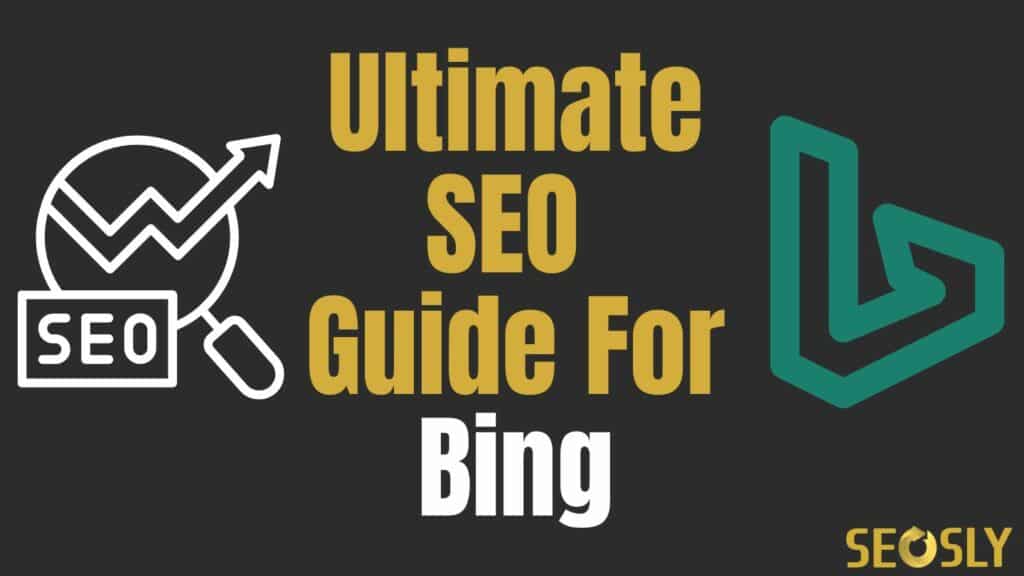
SEO guide for Bing
Regarding SEO, you should not put all your eggs in one basket. It means you should think outside Google and consider other search engines. Bing is a great search engine to focus your efforts on.
Bing has been around for a while now but only recently started gaining serious traction in search engine market share. In fact, in May 2022, Bing had nearly 1.2 billion unique visitors worldwide, an increase from 1.1 billion in February 2022.
Of course, Google still dominates the market, with an 84.08% share in December 2022. But Bing isn’t so far behind, with a 9% share. And with recent improvements from Microsoft, who knows how much that share will grow?
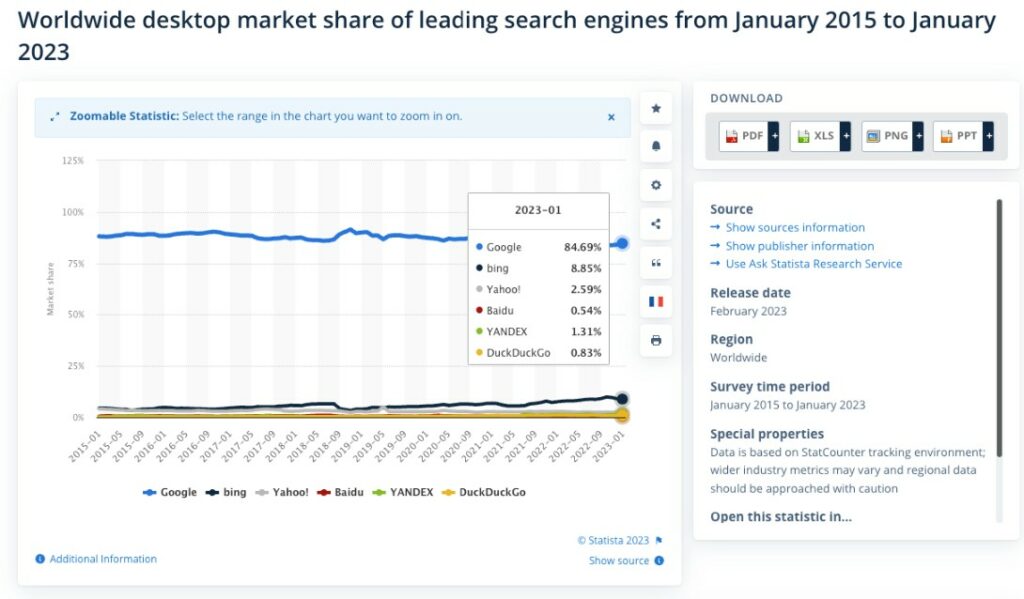
That’s why it’s essential to start optimizing for Bing now. But it’s not just copying what you’re doing for Google. Bing’s algorithm is different.
So if you want to get the most out of your SEO efforts, it’s essential to understand the differences between Bing and Google. And as someone who’s seen the benefits of expanding beyond Google, it’s worth the effort.
Bing’s SEO ranking factors
If you’re serious about optimizing for Bing, it’s crucial to deeply understand its search algorithm and ranking factors.
While much has been said about Google’s “200+ signals,” recent revelations from Yandex – Russia’s answer to Google – suggest that the actual number of ranking factors could be far higher.
In fact, Yandex’s recent data leak revealed a staggering 1,992 ranking factors – a number that has left many SEO experts reeling.
But what about Bing? Does it have a similarly vast array of ranking factors, and how exactly does it operate?
So now, let’s dive deep into the algorithm and ranking factors that make Bing tick. Let’s get started!
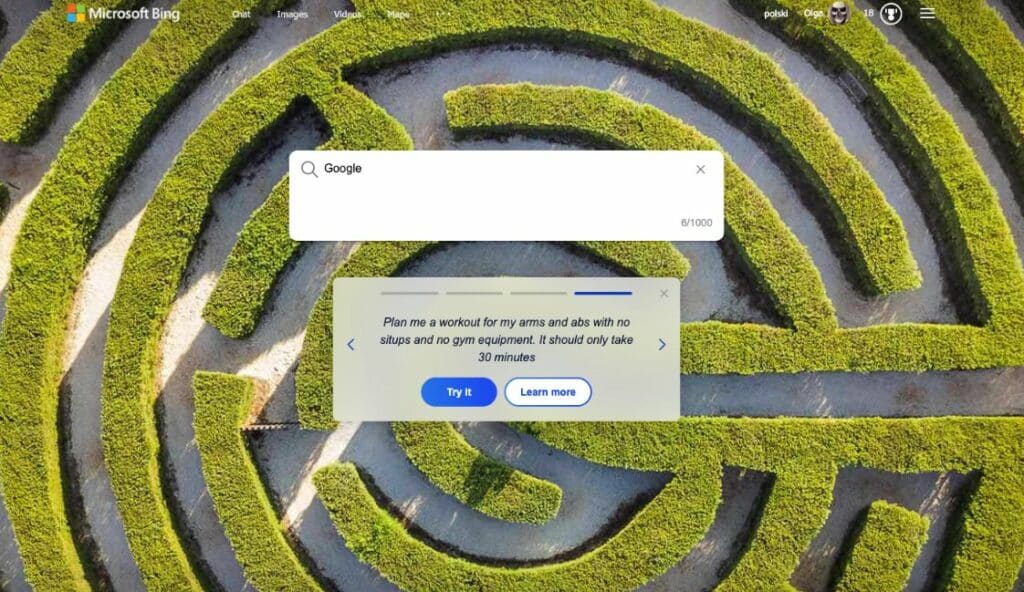
It’s no secret that Bing’s search algorithm is one of the most powerful and complex algorithms. It’s designed to serve its users with accurate, up-to-**** results for any query – from simple to complex.
It stands to reason that if you want your website or content to be found by the millions who use Bing every day, you need to understand how this algorithm works.
Bing is pretty open in its Bing Webmaster Guidelines about what you should do if you want to do well in Bing. If you haven’t read that document yet, you should definitely do it.

Below is the recap of the main ranking signals Bings uses to rank pages in the search results. Unsurprisingly, most (if not all of that) overlap with Google’s ranking factors and recommendations).
Relevance of the content
Relevance is how closely the content on a website relates to the search query someone is typing into a search engine. Bing looks to match terms used in the query to terms used on the page and phrases used in links referring to the page.
Bing also considers synonyms and abbreviations to provide a range of results matching the user’s query.
If someone searches for “baseball bats,” Bing will look for pages that mention the words “baseball bats” as well as related words like “bat” and phrases like “hitting a home run.”
Quality and credibility of the website
Quality and Credibility look at how clear the website is in what it is trying to say, how easy it is to use, how it looks, and who is behind it.
It also looks at how authoritative the website is, including how well-known and respected the author is, how well it explains and backs up the information it presents, and if the website is open and honest about who is behind it.
All these elements help show if the website is of good quality and can be trusted.
A well-designed and easy-to-use website would be considered high quality, while a website written by an expert in the field would be more credible.
User engagement
User engagement is a measure of how people interact with your website. It tells Bing how interested, or involved people are when they visit your website.
When someone searches, Bing will examine how people respond to the results. Did they click on the results and stick around to explore them, or did they quickly return to the search engine? If people spend time exploring the results, it indicates user engagement.
Bing can also look at other things, like whether people adjusted their search query or clicked through multiple search results. Bing can then use this information to improve the quality of the search results in its displays.
TIP: The Bing Webmaster Dashboard will show you how people interact with the web pages you have created.
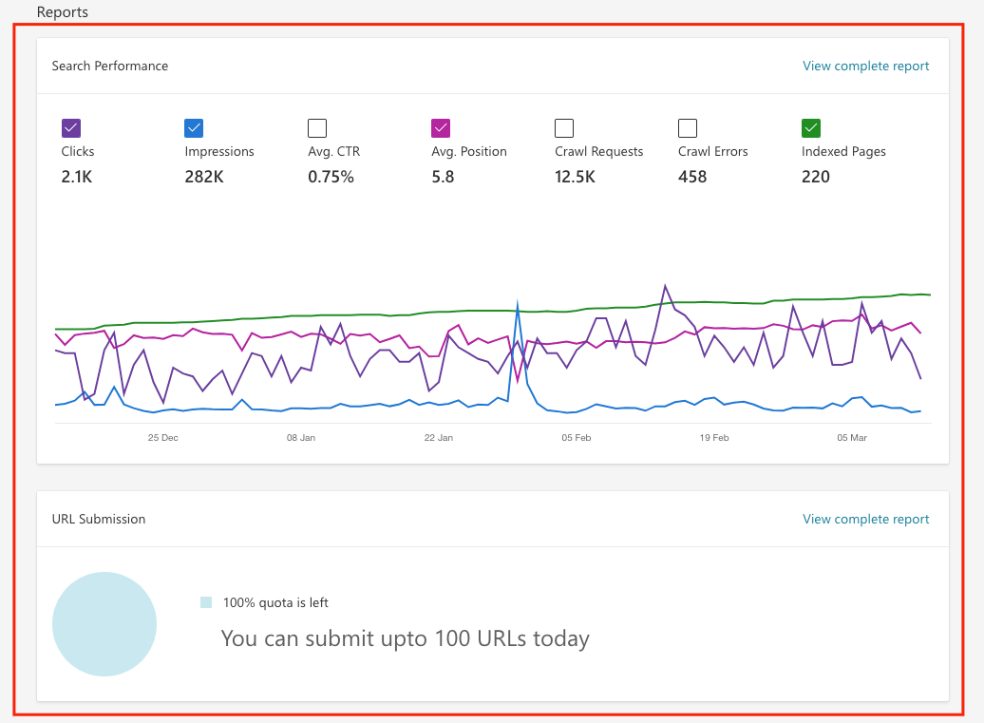
Microsoft Clarity
Talking about user engagement, I need to mention Microsoft Clarity.
Microsoft Clarity is a fantastic tool that helps website owners gain valuable insights into their website’s performance.
Clarity is a free analytics tool that provides detailed reports on user behavior, including click tracking, scroll tracking, and heatmaps.
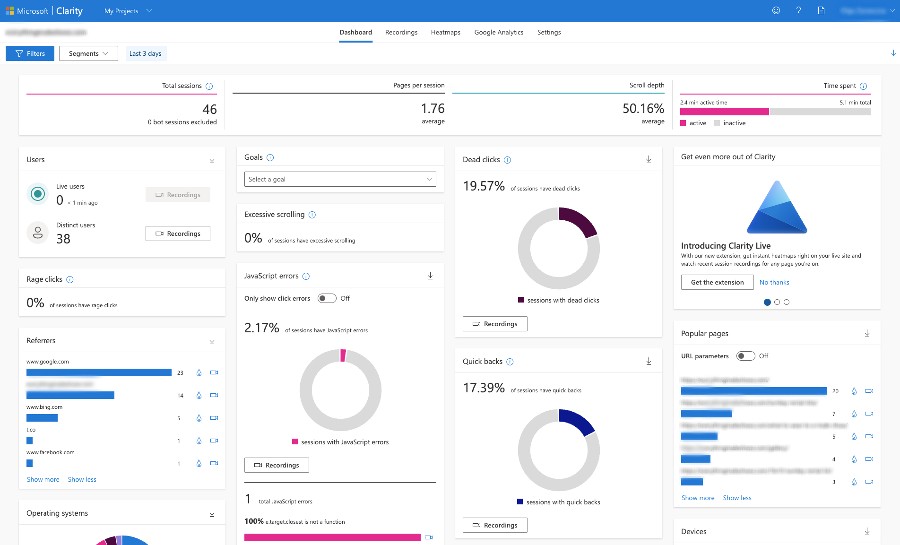
One of the coolest features of Clarity is its ability to replay user sessions, allowing you to see exactly how users interact with your website. You can use this feature to identify user pain points, test new designs, and optimize your website’s layout for better performance.
Content Freshness
Bing generally prefers fresh content because it provides users with the most relevant and up-to-**** information.
If you search for information about the 2020 US Presidential Election, you will likely want to find a page with the most up-to-**** results. This means that a page created a year ago will not be considered “fresh” in this context.
On the other hand, a page that has been regularly updated with the most recent election results is considered “fresh.”
Location
Bing looks at various things when it decides which web pages to show you when you type something in the search bar.
- If a user searches for a restaurant in Los Angeles, Bing’s results will be restaurants in Los Angeles. This is because Bing would be taking into account the user’s location.
- Bing also takes into account where the page is hosted. If a website is hosted in the United States, Bing will prioritize it over one in Europe.
- The language of the page is also taken into account. So, if a user searches for a website in Spanish, Bing will prioritize results written in Spanish.
- Finally, Bing considers the location of other visitors to the page. If many people from the United States visit a particular website, it will be ranked higher than those from other countries.
Page load time
When you visit a website, the page load time is the amount of time it takes for the website to display the content on the page. If the page load time is slow, it can be frustrating for visitors, and they may leave the website before the content has even loaded.
Bing views this as a poor user experience, so ensuring your page load time is as fast as possible is essential. But note that it is also important to ensure you provide a positive, helpful user experience, as this is more important than having a fast page load time.
Essentially, this is what Google recommends and wants you to do, i.e. Core Web Vitals.
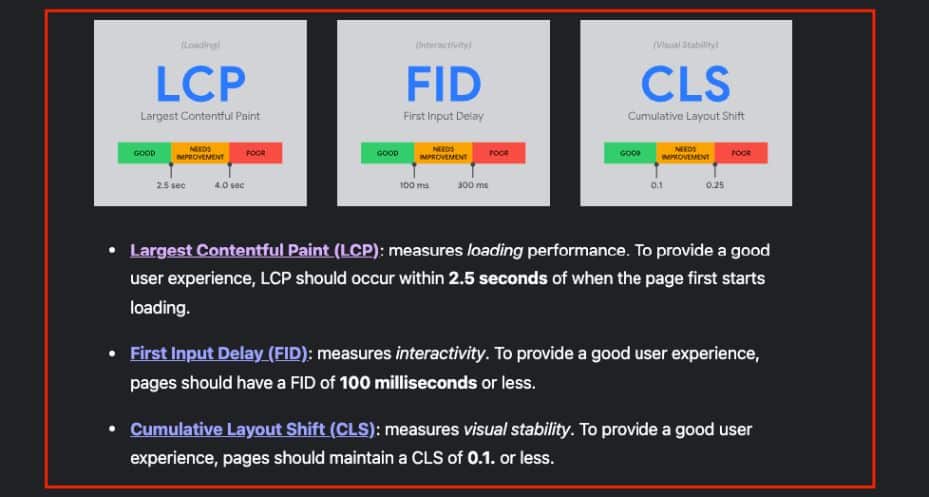
NOTE:
Bing uses specific criteria to rank websites in its search results, such as website relevance and quality content. These criteria remain consistent but can evolve over time and may vary depending on the search.
Does Bing favor Microsoft products and services in their search results?
Bing says they do not prioritize Microsoft products and services in their algorithmic search results. Still, they may feature them in standalone answer boxes or banners when relevant to the search. Also, Bing does not accept payment to improve organic ranking positions, meaning you cannot pay Bing to get higher-ranking positions in search results.
Again, unsurprisingly, this is pretty much the same with Google 😊
On-page SEO for Bing
On-page optimization techniques for Bing are like the foundation of a house; they provide structure, stability, and support.
To truly be successful on Bing (and Google), you should follow these tips:
Use visual assets (images and videos)
You should use images and videos specific to the content you are trying to convey. This could be a picture or video of a product you are discussing or a short video showing a process.
Bing can take the information from these images and videos, such as captions, titles, and transcripts, to help it understand the content on the page.
If you have an image of a on your page, Bing can use the caption, title, and structured data associated with the image to understand that the page is related to dogs.
Here are some tips you should remember when it comes to using images and videos in your content:
- Do not embed important text or information within images or videos, as it means putting the text in an image or video. This is not a good idea because Optical Character Recognition (OCR) software is not as reliable as HTML text in terms of accuracy and is not accessible to everyone. Instead, it is better to use alt text to make the content more accessible.
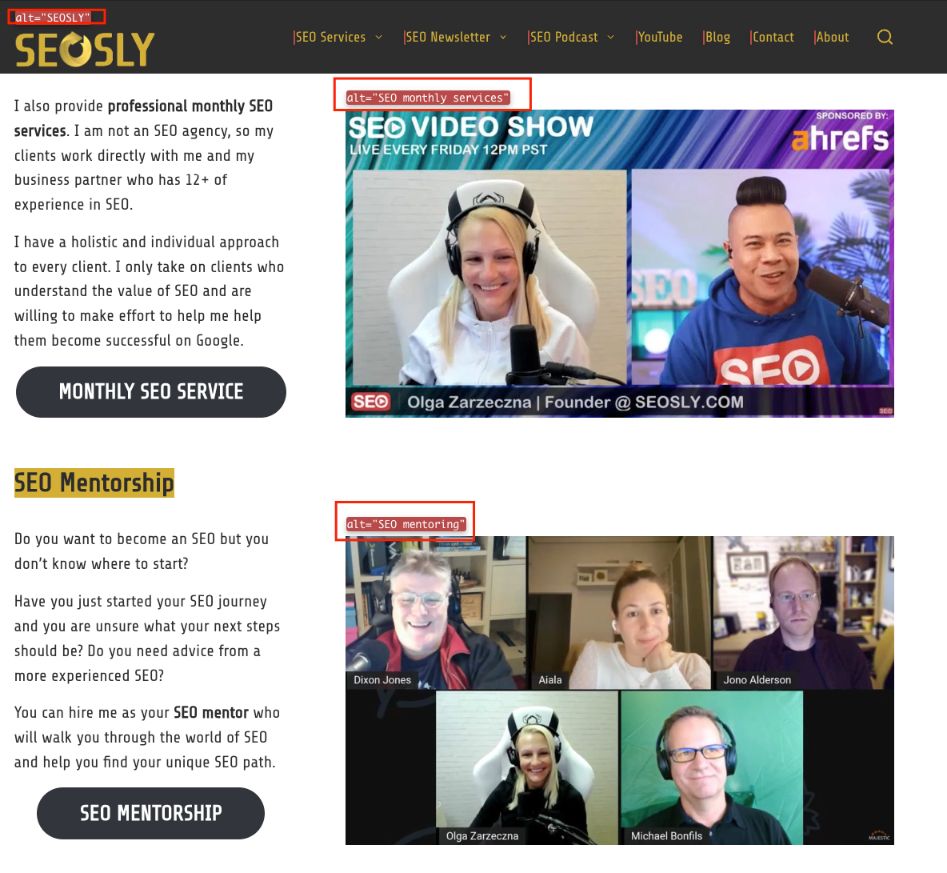
- Include descriptive titles, filenames, and text for images and videos to make the content more valuable.
- Make sure the videos are in a supported format and not blocked behind paywalls or logins.
- Use high-quality images and videos as it appeals more to users than blurry or out-of-focus images.
Optimize your videos and images
Optimize your images and videos to improve page load times and ensure they are not too large and take up too much space. If images and videos take up too much space, it can slow down how quickly a web page loads. This means it would take longer for the page to appear on a user’s screen.
When creating HTML elements and alt attributes, it is essential to accurately describe and reflect the page’s content. This will help users understand the content quickly and easily and help search engines categorize and index it more accurately, making it easier for users to find.
Here are some useful tips:
<TITLE>tags – The title should be descriptive and unique so that it accurately reflects the content of the page, making it easier for people to find the page online.If a website is about SEO, all of the pages in the website should have titles that include the word “SEO” and are unique from one another. A few examples of titles could be “Local SEO Audit” or “Technical SEO Audit.” This way, when people search for things related to SEO, they will be more likely to find the page they are looking for.
<META name= "description">– The description can help potential viewers understand the webpage and decide whether they want to view it. Writing a relevant description that accurately summarizes the webpage and provides context for viewers is important.If you are searching for a website about a video game, the description should include details about the game, such as its genre, publisher, and release ****. This information can help viewers decide if the website is what they are looking for.
- Alt attributes – Alt attributes are used to describe an image on a website and provide additional information about the image, allowing people using screen readers or other tools to understand what the image is.
If your content has an image of a , the alt attribute might say, “Golden Retriever pup standing in a field.” That way, a user who can’t see the image can still understand it.
<H1>tag – The H1 tag is meant to help users understand what the page is about and make it easier to find the information they are looking for. If you were looking for information about a particular topic on a website, the H1 tag would be the first thing you’d see, giving you an idea of what the page is about.For example, if you were on a website about pigeons, the H1 tag might be “Everything You Need to Know About Pigeons.” This helps the user understand the page before they start reading. Additionally, using H1 tags can help search engines determine the content of a page and rank it in search results.
<H1>-<H6>Header tags – Using headings helps search engines like Bing understand the structure of a page and the content of each section.For example, if a page has an
<H1>header tag for the title and<H2>tags for the different sections, Bing can quickly identify the page’s title, and the page’s different sections. This can help Bing determine how to rank the page for relevant search terms.
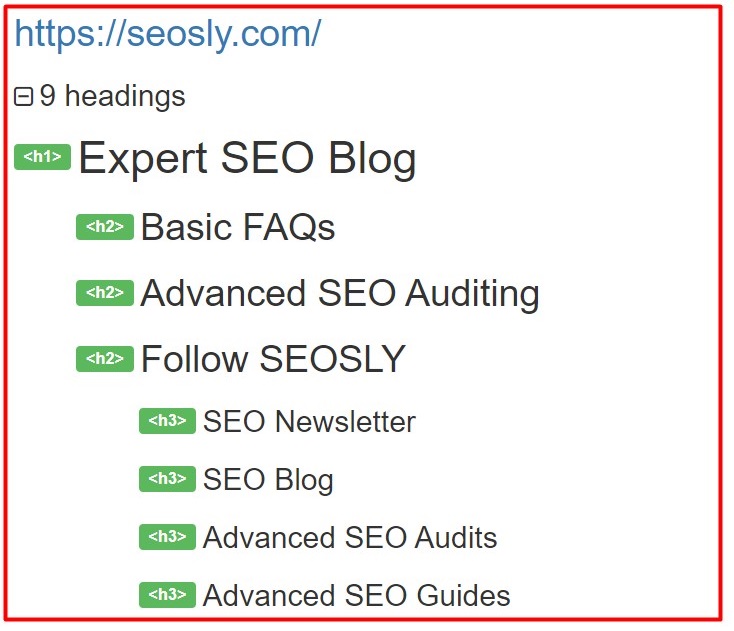
SEO Guide for Bing: Content
Like Google, Bing wants to ensure that the content it shows users is relevant, valuable, and helpful.
Therefore, the content you create for your website must be clear, unique, high-quality, and easy to find. If you provide content that is helpful to people, Bing will be more likely to show it in their search results.
Here are the guidelines to make sure Bing likes your content:
Create engaging content
To rank your website or pages on Bing, your website needs interesting and engaging content for those who visit it.
This means that the content should be easy to navigate, have lots of information, and provide the answers to any questions that a visitor might have.
Websites filled with ads and affiliate links or quickly redirect visitors to other sites tend to get lower rankings on Bing. In some cases, they may not even be indexed at all.
For example, a website about a new movie should have information about the movie, a trailer, reviews, and possibly even interviews with the cast and crew. Anything less than that won’t be as beneficial for the website’s ranking.
Craft content for search users, not engines
When creating content for a website, the content should be written for the people searching for it rather than for the search engines.
This means the content should be written with the user in mind, not just to get a higher ranking in search engine results.
For example, when creating a blog post about a particular topic, it should be written in a way that is easily understood by the reader, using expressive language and examples instead of just using keywords to get a higher ranking in the search engine results.
Write enough content
The content should provide enough information to meet visitors’ expectations of your website. This could be in the form of text, images, videos, or other forms of media.
The key is to provide enough content to answer all the questions a visitor might have.
For example, if you were running a website about sports cars, you would want to provide detailed information about the vehicles, including their specifications, performance, and features.
You should also provide plenty of images and videos so visitors can get a good sense of what the car looks like and how it drives.
Note that there is no specific number of words you need to have on each page, but the more relevant content you provide, the more helpful it will be for visitors.
Write original and creative content
Avoid using content from other websites or sources on your own website. The content should not be copied and pasted from another source but should be written in your own words.
Note: If you are hosting a video from another website, you should use the canonical tag to identify that website as the original source.
Make sure your content is discoverable
Having discoverable content on your website is critical for SEO. In order for search engines like Bing to crawl and index your website, it’s essential to have content that is easy to find and understand.
It means that when using technologies like JavaScript, you make sure that Bing does not have any problems crawling and indexing content added with JS.
Make sure the content is user-friendly and accessible
Ensure your website’s content is accessible to everyone and easy to understand. Test how your website works with devices like screen readers, which read out the information on the page instead of displaying it visually.
This can help you ensure that the descriptions of images and videos are accurate and that the website is easy to navigate and understand.
Testing for usability can help you spot any problems with the website setup, such as how it reads, the tables, and the way forms are presented.
Bing & links
Just a heads up, I’m not a link-building expert, but I’ve learned a thing or two from my experience in SEO.
While there are tons of guides out there specifically about building links, my approach has always been to focus on creating high-quality, awesome content.
In my experience, creating valuable content that people want to share and link to is one of the best ways to naturally generate links.
However, whether these links are enough to boost your rankings depends on a lot of factors. Factors like your niche, your website, your content, your competition, and more can all play a role in how effective your link-building efforts are.
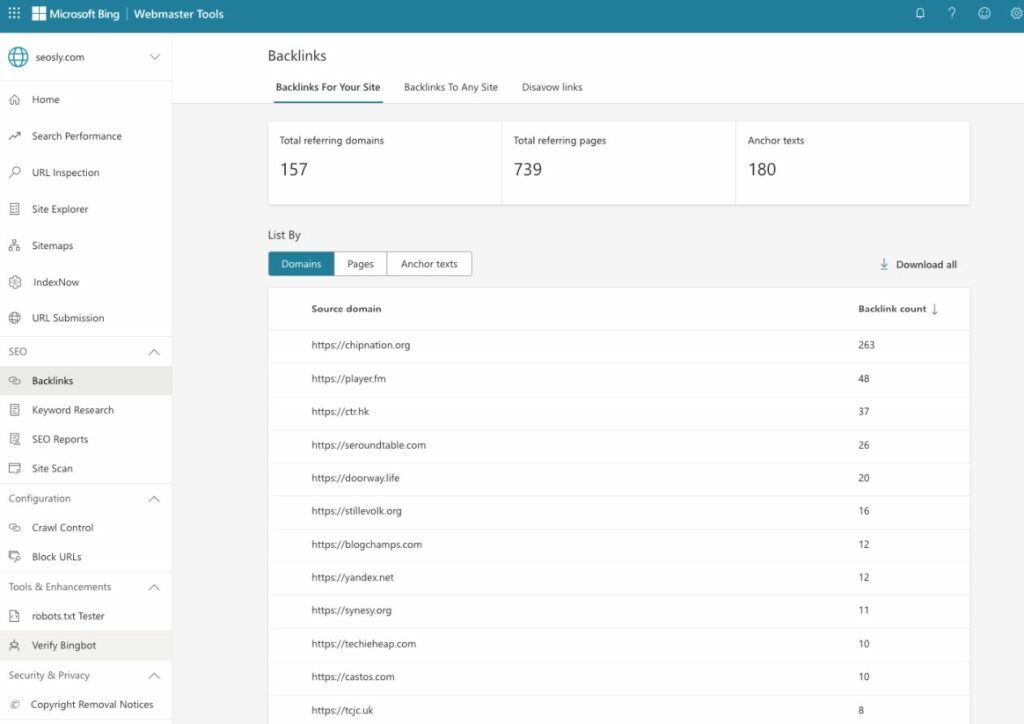
So, while creating great content is a good starting point, it’s important to consider other factors and adjust your approach as needed to ensure you’re getting the best possible results.
Technical SEO for Bing
Regarding technical SEO considerations in Bing, here are common technical SEO tips that also work with Google.
Submit a sitemap to Bing Webmaster Tools
Make sure you submit your sitemap to Bing using the Bing Webmaster Tools Sitemap tool. You can also ensure your sitemap is available to Bing by referencing it in your robots.txt file.
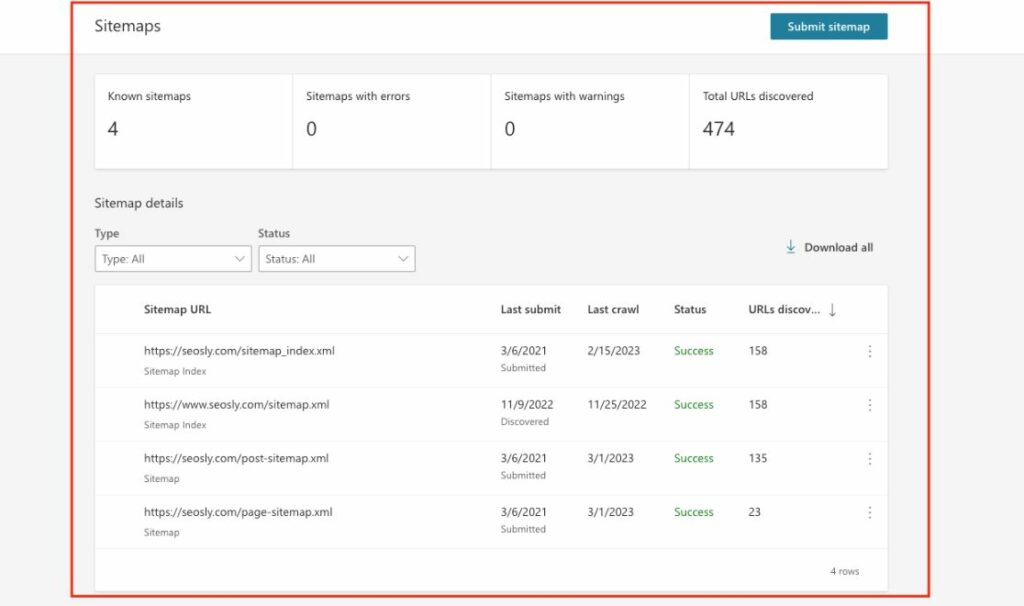
You can do this by inserting the following line in your robots.txt file:
Sitemap: https://seosly.com/sitemap.xml
Generally, all XML sitemap recommendations apply both to Bing and Google.
Use Noindex Tag to block URLs in the Bing search results
If you want to block URLs from showing up in the Bing search results, use the noindex meta tag.
<meta name="robots" content="noindex">- The code should be added to the HTML header of a page on your website.
- To ensure Bingbot reads the tag, you should allow it to access the pages with the NOINDEX tag in your robots.txt file.
Make secondary content (CSS, Javascript) crawlable
Allow secondary content such as CSS style sheets and Javascript to be crawled by robots.
- Doing so allows search engine crawlers to understand how the website is structured and how it looks.
- Also, keep in mind to limit the use of dynamic loading of resources like AJAX, as it helps reduce the number of HTTP requests that the website sends and limits the amount of JavaScript used on large websites.
- This will help the website to run more efficiently and make it easier for search engine crawlers to access the content.
Save Resources for faster loading speed
Use HTTP Compression and Conditional Get to save resources.
- This will help reduce the data (bandwidth) used when web crawlers and customers load web pages.
- This will also make web pages load faster while using fewer resources.
Implement redirects correctly
You can only use a 301 permanent redirect if the content is at the new location for at least three months.
- If the move is only temporary, lasting less than one day, then a 302 temporary redirect should be used.
- Remember to not use a rel=canonical tag, as this will not tell the search engines or visitors to your website to look for the content at the new location.
Use Semantic Markup
Using Schema markup adds extra information to web pages and helps Bing and other search engines understand what the page is about.
- This additional information may allow search engines to display special features when your page appears in search results.
- To ensure your semantic markup is working correctly, you should use a URL Inspection tool.
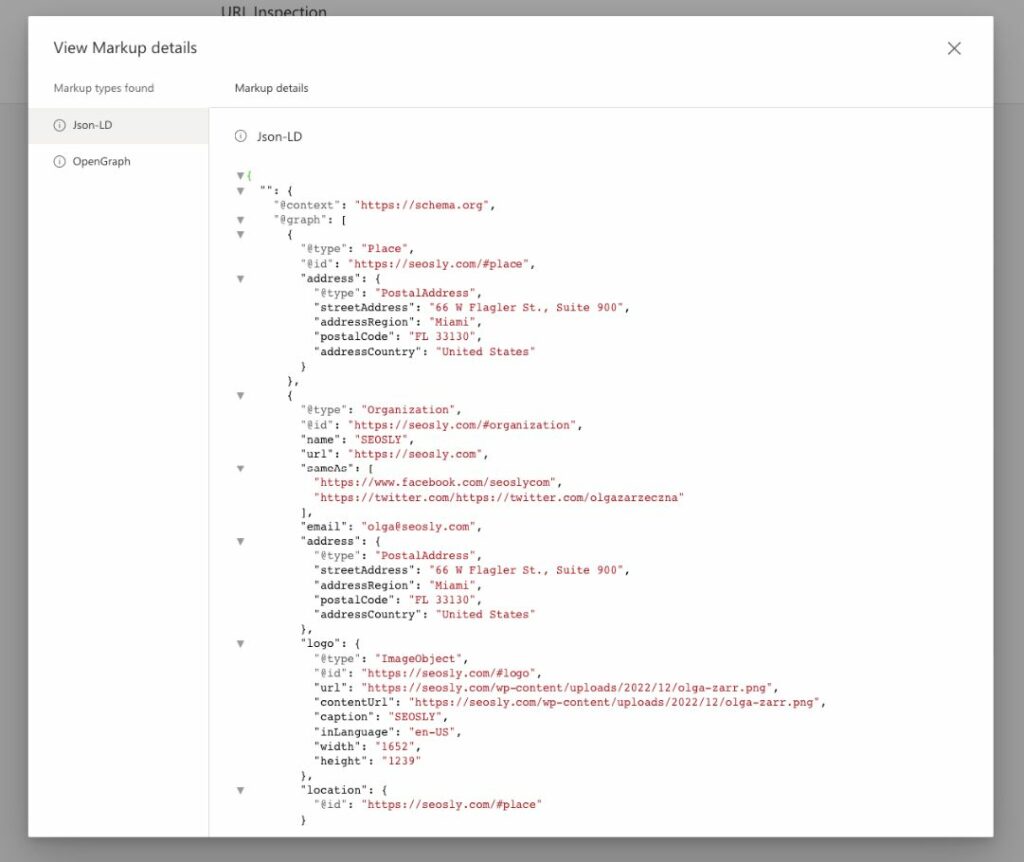
Use Bing Content Removal and Page Removal Tool
To remove content from Bing’s index, you can use the Bing Content Removal and Page Removal tools to ask for it to be removed.
- This will return a 404 “Not Found” HTTP code which tells the website and search engines that the content is no longer available.
- However, this content removal request will only last for a maximum of 90 days, so if you want the content to stay removed, you need to renew the request, or the content may reappear in the search results.
Optimize JavaScript
Bing is capable of handling JavaScript, although there are certain constraints when it comes to rendering JavaScript on a large scale while minimizing the number of HTTP requests.
- To address this issue, Bing suggests using Dynamic Rendering to alternate between client-side rendered and pre-rendered content for certain user agents like Bingbot, particularly for larger websites.
Not recommended Bing SEO techniques
Below is a list of black hat old SEO techniques that are not recommended (and which don’t work anymore) if you want to avoid being penalized by Bing or Google.
Cloaking
Cloaking involves showing a different version of your website to search engines than what regular visitors see.
For example, a website might show a page full of keywords and phrases to a search engine in order to seem more relevant and get higher rankings, while regular visitors would see a completely different page with no keywords.
This practice is considered a form of spamming and can result in your website being removed from the search engine’s index.
Automatically generated content
This type of content is usually not useful and can even be harmful, as it can be used to manipulate search engine rankings. Bing will penalize websites for using this type of content, as it is seen as an attempt to game the system.
Examples of machine-generated content are spam emails, online ads, and articles created by algorithms.
Keyword Stuffing
Keyword stuffing is a practice where a website is filled with keywords and phrases to manipulate search engine rankings.
For example, if a website wants to rank higher on a search engine for “SEO Consultant,” they might repeatedly stuff the page with that phrase in the content and meta tags.
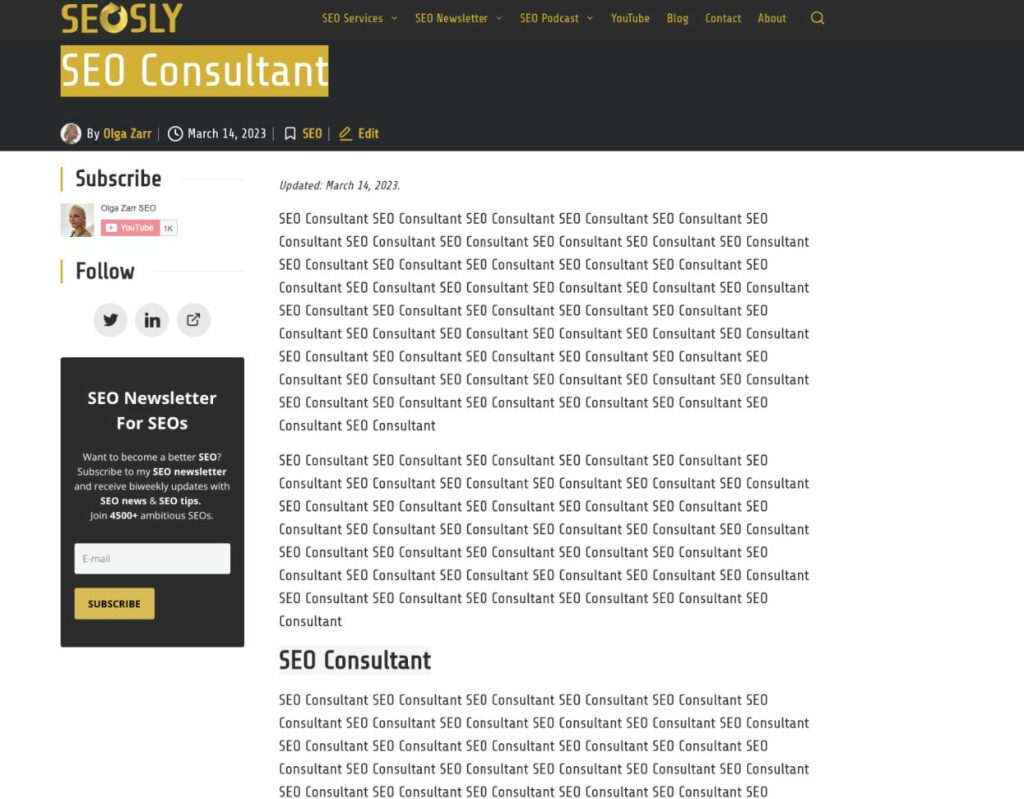
This practice is often used to try to fool search engines into thinking that the page or website is more relevant to the search query than it actually is. It violates Bing guidelines and can lead to the website being penalized or even removed from the search engine’s index.
Scraped Content
Scraped content is content that has been copied from another website without permission.
If you visited a website and found that the same article or text appears on multiple websites, it has likely been scraped. This means that one website has taken content from another and used it on its own website.
This is usually not allowed, as it can be seen as copyright infringement or plagiarism. Instead of simply copying content from other websites, you should create original content that adds value to your users and makes your website stand out. This means adding your unique spin on the topic or writing something new.
In addition, slightly modifying the content from another website and republishing it can be considered scraping.
How to measure & track SEO success in Bing
The journey of SEO is like a never-ending game of hide and seek. Just when you think you’ve found the perfect hiding spot, Bing drops in with an update that changes everything.
You have to start looking again — but this time, your goal isn’t just to find the right place but also to measure your efforts’ success.
That’s what measuring and tracking SEO success in Bing is all about.
When it comes to gauging success, there are two main approaches that you can take:
- Quantitative analysis which focuses on raw data such as rankings, clicks, impressions, etc.
- Qualitative analysis which looks at user experience metrics such as engagement rate or average session duration.
Both methods offer valuable insights into the effectiveness of your strategy, so make sure to utilize them together for maximum impact.
These are steps in measuring and tracking SEO success in Bing:
- Track progress over time by setting benchmarks before embarking on any campaigns or initiatives. This lets you see if particular tactics worked better than others, informing your decisions moving forward.
- Gather additional context for interpreting results by keeping tabs on competitor activities.
- Understand current trends and understand baseline performance levels across various channels and devices.
- Take actionable steps towards improvement, such as making tweaks to existing content or developing new strategies.
- Track changes to determine their efficacy down the line
With enough hard work and dedication, even seemingly minor adjustments can yield great rewards!
How to stay up-to-**** with Bing SEO
Here’s what you need to do to stay updated with Bing SEO:
- Subscribe to relevant newsletters, blogs, and forums related to SEO. This will ensure you always have access to industry experts’ latest tips and tricks and any new developments regarding search engine algorithms or features.
- Track your progress regarding organic traffic levels and keyword ranking performance. It’s also essential not just to monitor what others are saying but also to track your progress in organic traffic levels and keyword ranking performance over time.
- Use web analytics tools to measure data and identify trends. Web analytics tools allow you to measure data accurately and identify trends that could impact your overall visibility in search engines like Bing.
- Keep up with Bing SEO news and information through social media channels. Many businesses use Twitter, Facebook, Instagram, LinkedIn, or YouTube SEO channels to share content that can provide valuable insights into competitors’ strategies or simply ideas for optimizing pages better.
- Build relationships with other professionals for detailed advice.
TIP: Remember to consider the value of networking online, too; many experienced digital marketers have succeeded by connecting with peers via professional networks such as Linkedin.
P.S. Don’t miss my guide with Bing search operators.
P.S.2. I – Olga Zarr – am not the original author of this article. However, I did my best to proofread it and correct it so that it is as good as other articles on the SEO blog by SEOSLY.
